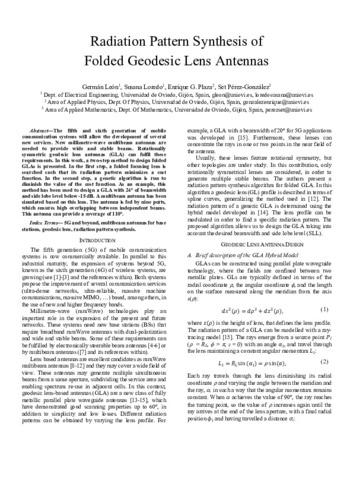Radiation Pattern Synthesis of Folded Geodesic Lens Antennas
Autor(es) y otros:
Palabra(s) clave:
Antenas 5G Lentes mmwave
Fecha de publicación:
Editorial:
EURAAP
Resumen:
The fifth and sixth generation of mobile communication systems will allow the development of several new services. New millimetre-wave multibeam antennas are needed to provide wide and stable beams. Rotationally symmetric geodesic lens antennas (GLA) can fulfil these requirements. In this work, a two-step method to design folded GLAs is presented. In the first step, a folded focusing lens is searched such that its radiation pattern minimizes a cost function. In the second step, a genetic algorithm is run to diminish the value of the cost function. As an example, this method has been used to design a GLA with 24º of beamwidth and side lobe level below -15 dB. A multibeam antenna has been simulated based on this lens. The antenna is fed by nine ports, which ensures high overlapping between independent beams. This antenna can provide a coverage of 110º.
The fifth and sixth generation of mobile communication systems will allow the development of several new services. New millimetre-wave multibeam antennas are needed to provide wide and stable beams. Rotationally symmetric geodesic lens antennas (GLA) can fulfil these requirements. In this work, a two-step method to design folded GLAs is presented. In the first step, a folded focusing lens is searched such that its radiation pattern minimizes a cost function. In the second step, a genetic algorithm is run to diminish the value of the cost function. As an example, this method has been used to design a GLA with 24º of beamwidth and side lobe level below -15 dB. A multibeam antenna has been simulated based on this lens. The antenna is fed by nine ports, which ensures high overlapping between independent beams. This antenna can provide a coverage of 110º.
Descripción:
European Conference on Antennas and Propagation (17th. 2023. Florence, Italy)
Patrocinado por:
This research was supported in part by the Ministerio de Ciencia e Innovación under Project PID2020-114172RB-C21 (ENHANCE-5G), by the Gobierno del Principado de Asturias and Fondo Europeo de Desarrollo Regional (FEDER) under Project grant AYUD/2021/51706, and by Vicerrectorado de Investigación of Universidad de Oviedo under Plan de Apoyo y Promoción de la Investigación under Project Papi21-GR-2010-0015
Colecciones
Ficheros en el ítem





